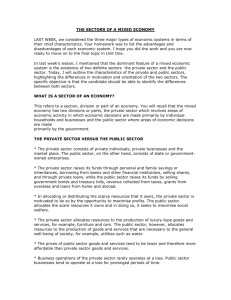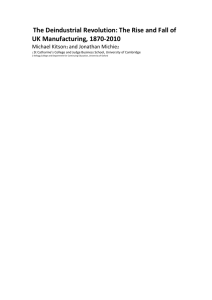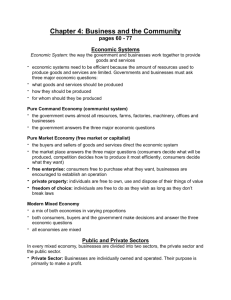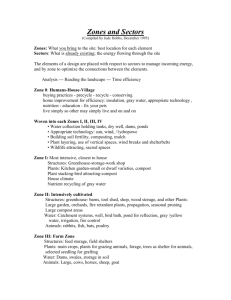the lecture
advertisement
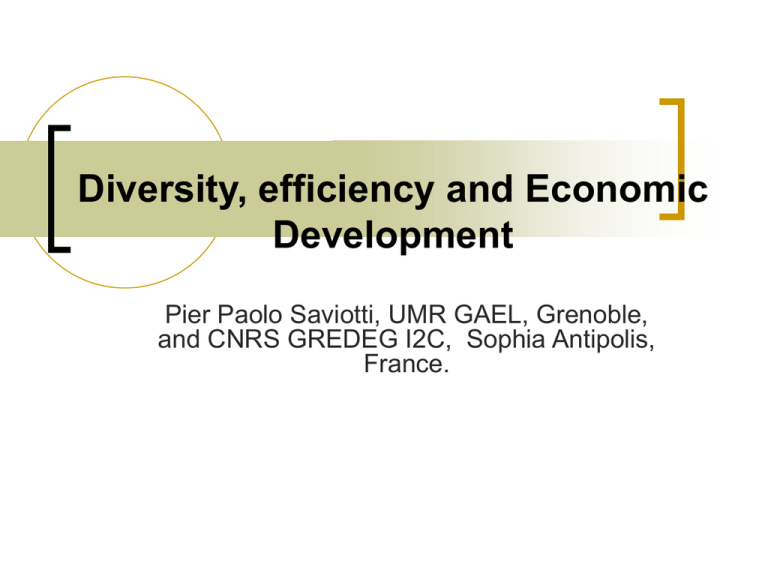
Diversity, efficiency and Economic Development Pier Paolo Saviotti, UMR GAEL, Grenoble, and CNRS GREDEG I2C, Sophia Antipolis, France. Acknowledgments Andreas Pyka Koen Frenken Jackie Krafft Econ Dev, Stylised facts STF1) Economic development is characterised by qualitative change. STF2) The efficiency of existing processes increases in the course of economic development. STF3) The diversity/variety of the economic system rises during the process of economic development. Efficiency vs diversity Efficiency grows when the same type of output is produced with (a) decreasing quantities of all inputs or (b) decreasing costs of all inputs What happens if the nature of the output changes? Is a pair of shoes costing 100 € produced five times less efficiently than a pair of shoes costing 20 €? Efficiency vs diversity In a strict sense comparisons of efficiency are only possible at constant output The 100€ pair of shoes has higher quality Efficiency at constant quality Qualitative and Structural Change Qualitative change: emergence of new entities, qualitatively different (distinguishable) from the pre-existing ones. Structural change: change in the structure of the economic system (components + linkages/interactions). Defined at the level of aggregation of industrial sectors. But: Structural change can occur at lower levels of aggregation. Qualitative and Structural Change (2) Structural change can occur for activities and actors as well as for outputs. Thus also for knowledge, and institutions. Qualitative change broader than structural change. Importance of qualitative/structural change. They affect the composition of the economic system. They are determinants of system performance. Economic development is a process of transformation, involving both quantitative/efficiency change at constant composition and qualitative change. Variety Definition: number of actors, activities and objects required to describe the economic system at a given time Variable to represent analytically changes in composition. Diversity Stirling Diversity overarching phenomenon with three components: Variety: number of distinguishable entities in a system Balance: distribution of distinguishable entities in a system Disparity: extent of difference between any two distinguishable entities Diversity All else being equal, the greater the variety the greater the diversity All else being equal, the more even is the balance the greater the diversity All else being equal, the more disparate are the represented elements the greater the diversity Modern phenomena Most people could only purchase the bare essentials to survive until the end of the XIXth century, and many people still do today Diversity existed only for the rich But in the XXth century change Efficiency and Diversity Two complementary forces/trajectories : growing efficiency growing diversity Hypothesis 1: The growth in diversity is a necessary requirement for long-term economic development. Hypothesis 2: Diversity growth, leading to new sectors, and productivity growth in pre-existing sectors, are complementary and not independent aspects of economic development. Compensation At constant output growing efficiency + saturating demand possibility to produce all demanded output with declining fraction of resources (labour force) Marxian trap Emergence of new sectors compensates for the falling capacity of existing sectors to create employment Growing diversity avoids Marxian trap. Economic development by the creation of new sectors A model in which the number of new sectors varies endogenously during economic development Sector created by an important innovation establishing an adjustment gap (size of the potential market) Model First entrepreneur enters the market (expectation of a temporary monopoly) imitators enter rising intensity of competition inducement for further entry falls until exit starts dominating entry. Innovation has become part of the ‘circular flow’ (Schumpeter, 1912-1934) Sector oligopoly or monopoly Adjustment gap gradually closed (saturated market) Industry life cycle Decline of mature sectors induces entrepreneurs to look for new opportunities of temporary monopoly, to be found by exploiting new important innovations leading to new niches and sectors. Competition Both intra- and inter-sector: Intra- sector: density of product/output population. Inter- sector: different sectors can provide comparable services. Entrepreneur induced by expectation of temporary monopoly to enter. If innovation successful imitation increasing intensity of competition decreasing inducement to enter exit Model equation dNi k1 * FAi * AGi ICi MAi (3) dt Search activities t t 1 SE 1 k 1 exp(k D ) i 4 5 acc, i Mergers and acquisitions N MC MA k AG t 1 t i i 9 t i t 1 i Demand function Yi * Yi Di pi Demand (2) Yi 1 1 exp( k14 k15 SEi ) Yi 1 1 exp( k16 k17 SEi ) pi 1 exp( k18 k19 SEi ) Number of firms (2) Life cycle: in each sector Ni first increases rapidly, reaches a maximum, and then falls (oligopoly, monopoly) But, life cycle driven purely by dynamics of competition and demand (See ILC models). Shape of life cycle affected by several variables (AGi, Di etc). number of firms 50 45 40 35 30 25 20 15 10 5 1 101 201 301 401 Adjustment gap Adjustment Gaps 1.8 1.6 1.4 1.2 1.0 0.8 0.6 0.4 0.2 1 101 201 301 401 t Intensity of competition Intensity of Competition 6 5 4 3 2 1 1 101 201 301 401 t Employment li = ki/Qia = ki/Qi/Ni = (ki*Ni)/Qi li = Li/Qi Aggregate employment Aggregate Employment 100 90 80 70 60 50 40 30 20 10 1 101 201 301 401 t Aggregate employment 100 75 50 25 0 1 251 501 751 Employment trend vs rate of growth of services Employment trend for variations of k 015 100 75 0.1 0.125 0.25 50 0.375 0.5 25 1 101 201 301 401 Demand experiments (2) Increasing the rate of growth of Yi (level of services supplied) Speeds up development raises demand, increases AGi, Changes the shape of the ILC and leads to a more positive employment growth path. Compensation The emergence of new sectors (growing variety) can compensate for the falling ability of mature sectors to create employment (Hypothesis 1) Economic development can be sustainable in the long run. The internal dynamics of each sector counts as well Creative destruction Process of industrial mutation that-if I may use that biological term- incessantly revolutionizes the economic structure from within, incessantly destroying the old one, incessantly creating a new one …. ….essential fact about capitalism….(p.83) ….perennial gale of creative destruction…(p. 84) (Capitalism, Socialism and Democracy) Interpretations Possible interpretations of creative destruction For every new innovation created a previous one disappears (Aghion and Howitt), considered by AH the true Schumpeterian character of their model. This implies: (i) Complete substitution of old by new, (ii) constant output diversity Diversity and creative destruction They are not incompatible, but, if variety grows there must be more creation than destruction. However, even old sectors which survive are not unaffected by the creation of the new. Old sectors/activities are transformed by new ones. Influence of competition on system performance Two (ideal) (opposite) types of competition (extremes of a range): Schumpeterian: do what no one else can do (radical innovation) temporary monopoly Classical: do the same thing as other competitors but better (i), (ii) (i) more efficient cheaper output (ii) better quality Intensity of competition N i * N tot ICi k 6 N i k 7 N tot ICi k IC N i * N tot N i RII N tot Overall IC vs IC + Inter-intra balance intensity of competition 1 kIC 0.9 5 6 7 0.8 8 9 0.7 0.6 0 0.005 0.01 0.015 0.02 0.025 0.03 0.035 0.04 0.045 0.05 Rii Rate of employment growth vs balance inter-intra-sector competition (Rii) for values of kIC. trend of employment 0,025 kIC 0,02 2 3 4 0,015 5 6 0,01 7 8 0,005 9 10 0 0 -0,005 0,02 0,04 0,06 0,08 0,1 Rii Trade-offs Inter-intra: predominance of intra-sector competition higher probability of temporary monopoly in niches elsewhere than in established sectors. If only Schumpeterian competition once sector created no imitation Classical competition production of the new good/service + efficient (cheaper) increased economic weight Industry life cycle In our model natural consequence of the dynamics of competition and of demand but not exclusive of other cyclical influences Different from other ILC models (Process R&D, Dominant designs, Refinement innovation) Demand - Search activities t t 1 SE 1 k 1 exp( k D ) i 4 5 acc, i Demand - Search activities (2) Yi 1 1 exp( k14 k15 SEi ) Yi 1 1 exp( k16 k17 SEi ) pi 1 exp( k18 k19 SEi ) Industry life cycle 90 90 80 80 70 70 60 60 50 50 40 30 40 30 20 10 20 10 - 1 251 k4 = 5 501 k4 = 7.5 k4 = 10 1 751 k4 = 12.5 k4 = 14 251 0.01 0.005 501 0.0075 751 0.025 1001 0.0125 140 120 120 100 100 80 80 60 60 40 40 20 20 - 1 251 k14 = 0.1 501 k14 = 0.5 k14 = 1 1 751 k14 = 1.5 k14 = 2 251 k15 = 0.1 k15 = 0.25 501 k15 = 0.5 751 k15 = 0.75 k15 = 1 Industry Life Cycle The shape, duration and existence of the industry life cycle is greatly affected by parameters affecting demand and search activities In some cases the shake out virtually disappears (existence) Micro-Macro dynamics 120 90 80 70 60 50 40 30 20 10 100 80 60 40 20 1 0 1 251 0.01 501 0.005 0.0075 751 0.025 251 501 0.0125 k5 = 0.005 k5 = 0.0075 k5 = 0.0125 k5 = 0.025 60 55 50 45 40 35 30 1 751 1001 251 501 Linear (0.005) Linear (0.0075) Linear (0.01) Linear (0.0125) 751 Linear (0.025) 1001 k5 = 0.01 Micro-Macro dynamics (2) The shape and duration of the ILC affects the macro-economic performance of the economic system Model parameters affecting demand and search activities can affect (i) the rate of creation of new sectors (ii) the number of firms in each sector (iii) the rate of growth of industrial concentration Micro-Macro dynamics (3) As consequence the effects of parameters affecting demand and search activities are often non-linear Ex: trade-off between faster rate of creation of new sectors and smaller number of firms in each sector. Efficiency vs diversity All these (and many other) phenomena are made possible by the complementary combination of efficiency and diversity More creation than destruction vs growing diversity Trade-off Schumpeterian (Diversity) classical (efficiency) competition Influence of ILC (shape etc) on macro dynamics rate sectors + sector size



